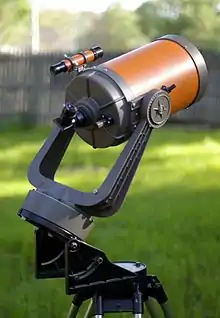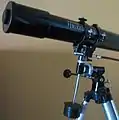Celestron
Celestron is a company based in Torrance, California, United States, that manufactures telescopes and distributes telescopes, binoculars, spotting scopes, microscopes, and accessories manufactured by its parent company, the Synta Technology Corporation of Taiwan.
| Type | Private |
|---|---|
| Industry | Optical instruments |
| Predecessor | Valor Electronics |
| Founded | 1964 (as Celestron Pacific) |
| Headquarters | , United States |
Key people |
|
| Products | Telescopes and other optical / mechanical devices |
| Website | Celestron.com |
History
The predecessor of Celestron was Valor Electronics, an electronics and military components firm founded in 1955 by Tom Johnson.[1][2][3] Johnson became involved with telescopes when he built a 6" reflecting telescope for his two sons.[2] In 1960, Johnson established the "Astro-Optical" division of Valor, which would later become Celestron.[3]
By 1964, Johnson had founded "Celestron Pacific" as a division of Valor Electronics[4] offering Schmidt-Cassegrain telescopes from 4" to 22". In 1970 Celestron introduced its "C8" 8" diameter 2032 mm focal length, ƒ10 telescope, the first of a new line of telescopes built using methods developed by Celestron to produce Schmidt-Cassegrains at a high volume and low cost.[1] These models made significant inroads into the amateur astronomical and educational communities.
Johnson, the founder of the company, sold Celestron in 1980.[2] Celestron was acquired by Tasco in 1997 and almost went out of business when Tasco folded in 2001.
In early 2002 Celestron's rival, Meade Instruments, attempted a takeover but a bankruptcy court allowed the sale of the company back to its original owners. The company had been U.S. owned until April 2005 when it was acquired by SW Technology Corporation, a Delaware company and affiliate of Synta Technology Corporation of Taiwan. Synta is a manufacturer of astronomy equipment and related components and at that time had been a supplier for Celestron for over 15 years.[5]
Products

Celestron was the first large scale commercial manufacturer of the Schmidt-Cassegrain telescope, introducing its "C8" 8" diameter 2032 mm focal length, ƒ10 telescope in 1970.[7] The primary innovation Celestron/Tom Johnson came up with was a way to produce Schmidt corrector plates using a vacuum to pull the glass blanks into a pre-shaped curve mold called a "master block" during the polishing process.[8][9] This allowed for the inexpensive mass production of corrector plates of uniform shape. The telescope line had a trademark matte orange tube (changed to glossy black in 1980, and back to semi-gloss orange in 2006), and double-fork equatorial mount, and became a popular large aperture, compact design.
Other telescope product lines include the CGE, CGEM, CPC, NexStar, Omni, Onyx, AstroMaster, Ambassador, TravelScope, and PowerSeeker product lines.[10] These range from large computerized reflectors with GPS to decorative/casual viewing telescopes with brass tube refractors on wood mounts.
Celestron products (as of 2010) include:
- 5", 6", 8", 9.25", 11", and 14" Schmidt-Cassegrain telescopes (the number denoting the aperture) on German equatorial mounts (all) or fork mounts (C8, C9.25, C11), with most benefiting from GoTo control.
- A range of 8", 9.25", 11", and 14" modified Schmidt-Cassegrains with a more advanced optical design
- A range of 2.4 to 6-inch (150 mm) refractor telescopes.
- 6 to 10-inch (250 mm) traditional reflector telescopes on German equatorial mounts.
- SkyScout – an astronomical sky finder or a personal planetarium.
- Digital, Biological, and Stereo viewing microscopes
- Binoculars and Spotting scopes
- Various mounts
- Numerous eyepiece lines, including both simple Plossl and complex wide-field designs such as the X-Cel and Luminos eyepiece lines.
 Celestron NexStar 114 telescope
Celestron NexStar 114 telescope.JPG.webp) Celestron C8 telescope
Celestron C8 telescope An Omni XLT120 achromatic refractor
An Omni XLT120 achromatic refractor Celestron NexStar 130SLT Goto telescope
Celestron NexStar 130SLT Goto telescope Celestron Powerseeker model 80EQ
Celestron Powerseeker model 80EQ
Celestron telescopes offer the option to use computerized location of astronomical objects as well as mounts that will aim themselves at any given object, a technology known as GoTo. Most of the computerized models can be connected to an external computer via an RS-232 cable, allowing them to be controlled by a third-party astronomy program or connected to a GPS receiver. GPS receivers are useful for programming the telescope with its precise location and time, which aids the alignment process required for GoTo.
Some motorized telescopes sold during the mid 80s to early 90s, including the Celestron Compustar® which used a form of GoTo technology, were not programmed to allow for dates after 2000; making some Celestron products susceptible to the Y2K bug. However, a third party chip to update the computer is available for some products.
Competition with Meade
Since their founding in 1972, Meade Instruments has been one of Celestron's chief rivals. Design, sizing, introduction, and pricing of each company's products lines and models have been in response to their competition with each other. There has been litigation over infringement of patents between the two companies, one instance regarding GoTo technology.[11] In September 2013, Sunny Optics Inc, a unit of the Chinese firm Ningbo Sunny Electronic Co Ltd, completed the acquisition of the entire share capital of Meade.
References
- Plotner, Tammy (August 1, 2008). "Celestron Telescope". Universe Today. Retrieved 2011-04-25.
- Ferron, Karri (2012-03-13). "Celestron founder dies at age 89, Tom Johnson founded the telescope company in 1960 and revolutionized the hobby with the Celestron 8". Astronomy Magazine. Retrieved 2012-03-28.
- di Cicco, Dennis (2012-03-13). "Tom Johnson, 1923–2012". Sky & Telescope. Archived from the original on 2012-03-17. Retrieved 2012-03-28.
- "Nights of Future Passed – Celestron Pacific". philharrington.net.
- prnewswire.com, Celestron Purchased by SW Technology Corporation, a Delaware Company, Affiliate of Synta Technology Corporation - TORRANCE, Calif., April 6 /PRNewswire
- "Tom Johnson Announcement". Celestron.com. March 13, 2012. Archived from the original on March 17, 2012. Retrieved March 17, 2012.
- James Mullaney (2007). A Buyer's and User's Guide to Astronomical Telescopes & Binoculars. Springer Science & Business Media. p. 51. ISBN 978-1-84628-707-7.
- Rod Mollise, Down with Love, uncle-rods.blogspot.com, Sunday, February 21, 2010
- Method for making replica contour block masters for producing schmidt corrector plates, United States Patent 3837124
- Guzman, Roxanne (2019-12-24). "Top 5 Best Low Light Binoculars in 2020". Woq9. Retrieved 2020-01-31.
- "Meade, Celestron Settle Patent Lawsuits". Bloomberg News. Bloomberg. July 9, 2004. Retrieved 2011-04-25.
External links
| Wikimedia Commons has media related to Celestron. |
